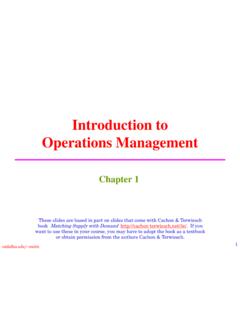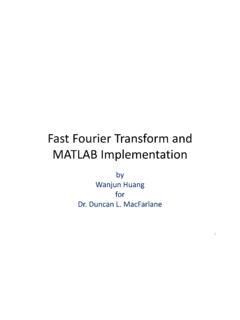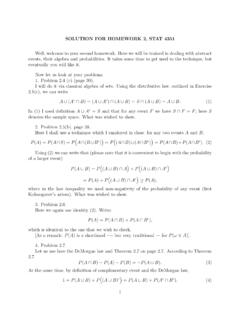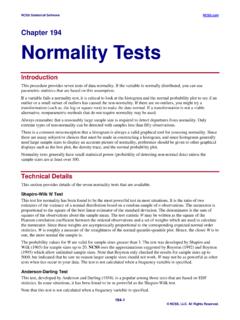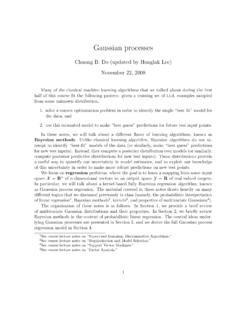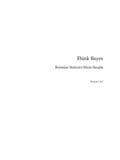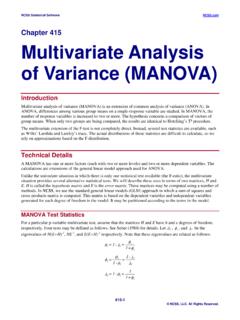Transcription of Important Probability Distributions
1 Important Probability DistributionsOPRE 6301 Important Distributions ..Certain Probability Distributions occur with such regular-ity in real-life applications that they have been given theirown names. Here, we survey and study basic propertiesof some of will discuss the following Distributions : Binomial Poisson Uniform Normal ExponentialThe first two are discrete and the last three distribution ..Consider the following scenarios: The number of heads/tails in a sequence of coin flips Vote counts for two different candidates in an election The number of male/female employees in a company The number of accounts that are in compliance or notin compliance with an accounting procedure The number of successful sales calls The number of defective products in a production run The number of days in a month your company s com-puter network experiences a problemAll of these are situations where the binomial distributionmay be Framework.
2 There is a set of assumptions which, if valid, would leadto a binomial distribution . These are: A set ofnexperiments ortrialsare conducted. Each trial could result in either asuccessor afailure. The probabilitypof success is thesamefor all trials. The outcomes of different trials areindependent. We are interested in the total number of successes the above assumptions, letXbe the total numberof successes. Then,Xis called abinomial randomvariable, and the Probability distribution ofXis calledthebinomial Probability -Mass Function..LetXbe a binomial random variable. Then, its Probability -mass function is:P(X=x) =n!x!(n x)!px(1 p)n x(1)forx= 0, 1, 2, .. , values ofnandpare called theparametersof understand (1), note that: The Probability for observinganysequence ofnin-dependent trials that containsxsuccesses andn xfailures ispn(1 p)n x. The total number of such sequences is equal to(nx) n!
3 X!(n x)!( , the total number of possible combinations whenwe randomly selectxobjects out ofnobjects).4 Example: Multiple-Choice ExamConsider an exam that contains 10 multiple-choice ques-tions with 4 possible choices for each question, onlyone of which is a student is to select the answer for every ques-tion randomly. LetXbe the number of questions thestudent answers correctly. Then,Xhas a binomialdistribution with parametersn= 10 andp= (Convince yourself that all assumptions for a binomialdistribution are reasonable in this setting.)What is the Probability for the student to get no answercorrect? Answer:P(X= 0) =10!0!(10 0)!( )0(1 )10 0= ( )10= is the Probability for the student to get two an-swers correct? Answer:P(X= 2) =10!2!8!( )2(1 )8= 45 ( )2 ( )8= is the Probability for the student to fail the test( , to have less than 6 correct answers)? Answer:P(X 5) =5 i=0P(X=i)= + + + + + probabilities can be computed using the Excelfunction BINOMDIST().
4 Two other examples are givenin a separate Excel Mean and Variance..It can be shown that =E(X) =npand 2=V(X) =np(1 p) .For the previous example, we have E(X) = 10 = V(X) = 10 ( ) (1 ) = distribution ..The Poisson distribution is another family of distributionsthat arises in a great number of business situations. Itusually is applicable in situations where random events occur at a certainrateover a period the following scenarios: The hourly number of customers arriving at a bank The daily number of accidents on a particular stretchof highway The hourly number of accesses to a particular webserver The daily number of emergency calls in Dallas The number of typos in a book The monthly number of employees who had an ab-sence in a large company Monthly demands for a particular productAll of these are situations where the Poisson distributionmay be Framework..Like the Binomial distribution , the Poisson distributionarises when a set of canonical assumptions are reasonablyvalid.
5 These are: The number of events that occur in any time intervalis independent of the number of events in any otherdisjoint interval. Here, time interval is the standardexample of an exposure variable and other interpre-tations are possible. Example: Error rate perpageina book. The distribution of number of events in an interval isthe same for all intervals of the same size. For a small time interval, the Probability of observ-ing an event is proportional to the length of the inter-val. The proportionality constant corresponds to the rate at which events occur. The Probability of observing two or more events inan interval approaches zero as the interval the above assumptions, let be the rate at whichevents occur,tbe the length of a time interval, andXbethe total number of events in that time interval. Then,Xis called aPoisson random variableand the proba-bility distribution ofXis called thePoisson t; then, can be interpreted as the average, ormean, number of events in an interval of Probability -Mass Function.
6 LetXbe a Poisson random variable. Then, its Probability -mass function is:P(X=x) =e xx!(2)forx= 0, 1, 2, ..The value of is theparameterof the distribution . Fora given time interval of interest, in an application, canbe specified as times the length of that : TyposThe number of typographical errors in a big textbookis Poisson distributed with a mean of per 100 pages of the book are randomly is the Probability that there are no typos? An-swer:P(X= 0) =e xx!=e != 400 pages of the book are randomly are the probabilities for having no typos andfor having five or fewer typos? Answers:P(X= 0) =e 4( 4)00!= (X 5) =5 i=0P(X=i)= + + + + + probabilities can be computed using the Excelfunction POISSON(). Further numerical examples of thePoisson distribution are given in a separate Excel and VarianceIt can be shown thatE(X) = andV(X) = .Interpretation of (2)The form of (2) seems mysterious.
7 The best way to un-derstand it is via the binomial a time interval and divide it intonequally-sizedsubintervals. Supposenis very large so that either oneor zero event can occur in a subinterval. Suppose furtherthat the Probability for an event to occur in a subintervalis /n, independent of what occurs in other these assumptions, the total number of events,X,in that interval has a binomial distribution with parame-tersnand /n. That is,P(X=x) =n!x!(n x)!( n)x(1 n)n x(3)forx= 0, 1, 2, .. , thatE(X) =n ( /n) = , suggesting that (3) and(1) are consistent. Indeed, it can be shown that asnapproaches , (3) becomes (2). This useful fact is calledPoisson approximationto the binomial will see several other examples of such limiting ap-proximations in future chapters. They provide simpleand accurate approximations to otherwise Continuous Distributions ..Recall that a continuous random variable or distribu-tion is defined via a probabilitydensityfunction.
8 Letf(x) (nonnegative) be the density function of ,f(x) is the rate at which Probability accumulatesin the neighborhood ofx. In other words,f(x)h P(x < X x+h)whenh(a positive number) is sufficiently small. It followsfrom this rate interpretation that for any interval (x1, x2],we haveP(x1< X x2) = x2x1f(x)dx;(4)moreover, we must have f(x)dx= that the Probability for a continuous random vari-able to assume any particular value is 0; this can be seenby settingx1=x2in (4).15 Recall further that the integral of a function over an inter-val is the area under that function over the given can therefore visualizeP(x1< X x2) as the areaof the yellow region below:f(x)xx1x216 For < x < , the functionF(x) P(X x) = x f(y)dy( , letx1= andx2=xin (4)) is called thecumulativedistribution function (x) can alsobe used to describe a random variable, sincef(x) is thederivative ofF(x).Various probabilities of interest regarding a variableXcan all be computed via eitherf(x) orF(x).)
9 We next discuss three Important continuous Distributions :uniform, normal, and distribution ..The uniform distribution is the simplest example of a con-tinuous Probability distribution . A random variableXissaid to be uniformly distributed if its density function isgiven by:f(x) =1b a(5)for < a x b < .Visually, we havef(x)xbawhere the shaded region has area (b a)[1/(b a)] = 1(width times height).18 The valuesaandbare the parameters of the uniformdistribution. It can be shown thatE(X) =a+b2andV(X) =(b a) density has parametersa= 0 andb= 1; and hencef(x) = 1 for 0 x 1 and 0 other-wise. The Excel function RAND() pretends to generateindependent samples from this density : Gasoline SalesSuppose the amount of gasoline sold daily at a servicestation is uniformly distributed with a minimum of2,000 gallons and a maximum of 5,000 is the Probability that daily sales will fall between2,500 gallons and 3,000 gallons?
10 Answer:P(2500< X 3000) =15000 2000(3000 2500)= , we havef(x)x5,0002,000and the answer corresponds to the area in is the Probability that the service station will sellat least4,000 gallons? Answer:P(X >4000) =15000 2000(5000 4000)= , we havef(x)x5,0002,000 What is the Probability that the service station will sellexactly2,500 gallons? Answer:P(X= 2500) = 0,since the area of a vertical line at 2,500 is (x)x5,0002,00021 Normal distribution ..The normal distribution is the most Important distrib-ution in statistics, since it arises naturally in numerousapplications. Thekey reasonis thatlargesums of(small) random variables often turn out to be normallydistributed; a more-complete discussion of this will begiven in Chapter random variableXis said to have the normal distrib-ution with parameters and if its density function isgiven by:f(x) =1 2 exp{ 12(x )2}(6)for < x < .It can be shown thatE(X) = andV(X) = , the normal distribution is characterized by a mean and a standard deviation.


